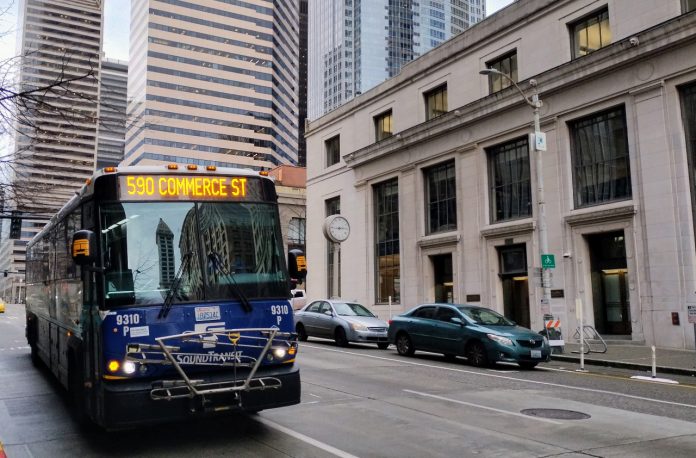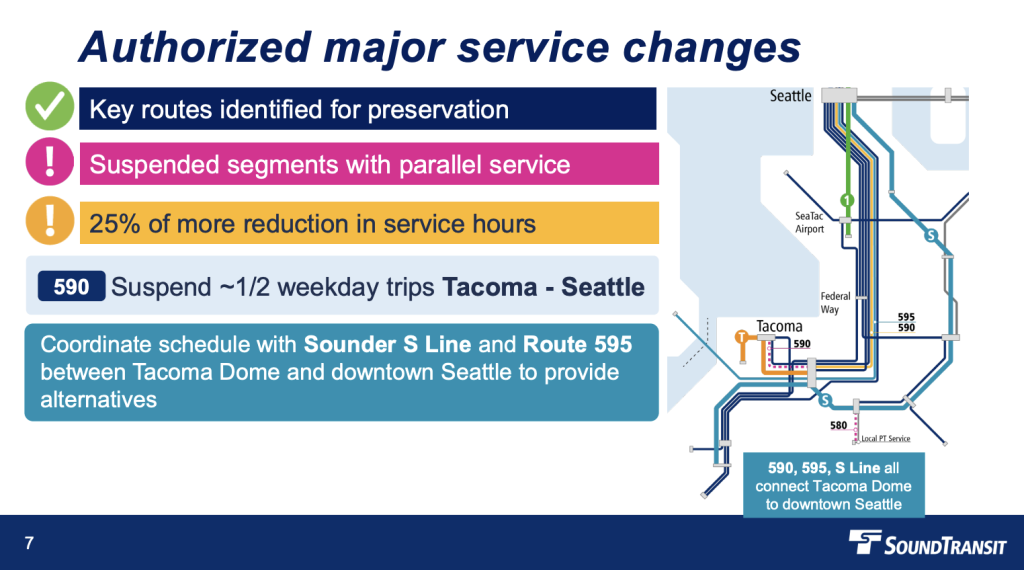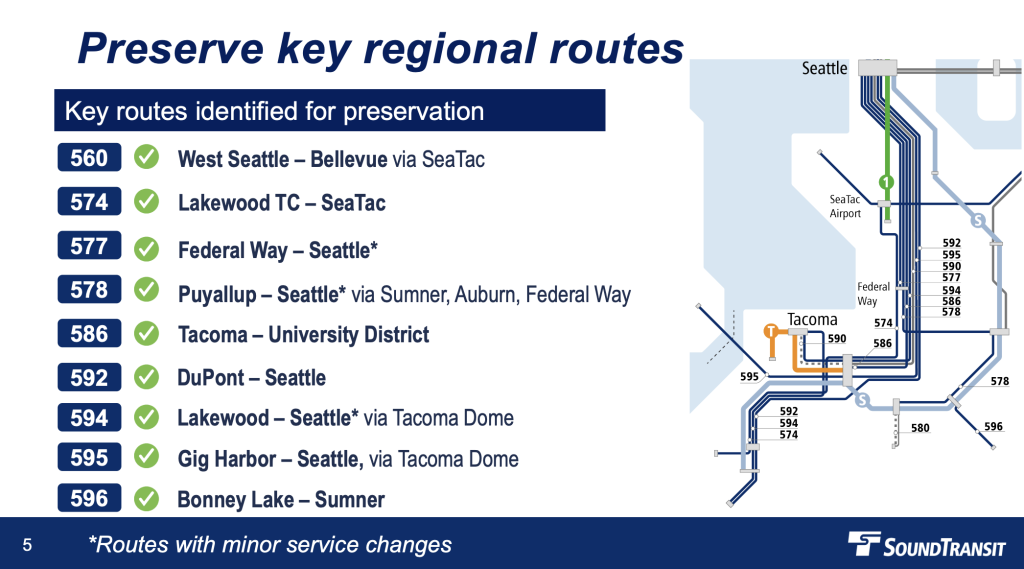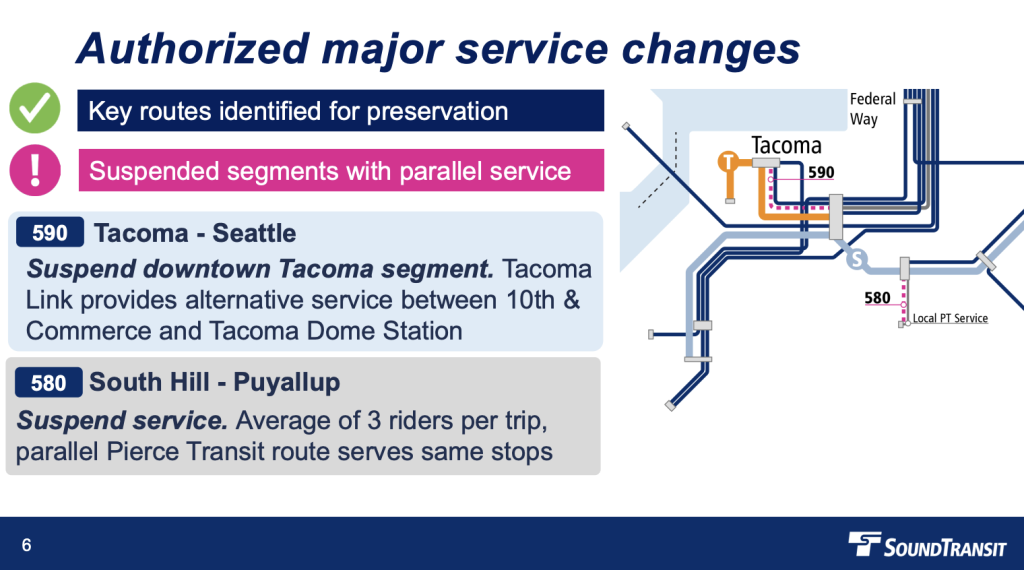
Riders heading between Tacoma, Puyallup, Federal Way, and Seattle will see fewer trips and some route revisions due to an operator shortage starting this spring.
On Thursday, Sound Transit staff detailed plans for service reductions on Pierce Transit-operated ST Express bus service. The agency anticipates a reduction of up to 10% on routes operating to, from, and within Pierce County and South King County starting in March.
Brian de Place, Sound Transit’s director of system and service planning, briefed the agency’s Rider Experience and Operations (REO) Committee on Thursday and blamed the service reductions on staffing levels.
“All of the partners in the entire industry have been challenged with staffing levels since Covid began,” de Place said. “Most recently, Pierce Transit identified the need to again reduce service levels due to these ongoing staffing changes.”
Currently, Pierce Transit has 426 transit operators and needs 433 to meet service obligations, making it difficult to operate the full schedule each day. Several dozen prospective operators, however, are going through training programs, which could backfill open positions and replace operators leaving their positions. Prior to the Covid-19 pandemic, 506 operators were needed to run the schedule at that time and Pierce Transit is technically still budgeted for that if staffing ever fully recovers. Within these numbers, ST Express is partially represented as Sound Transit contracts with them to operate service.
Rebecca Japhet, a Pierce Transit spokesperson, was able to share some data with The Urbanist that may also partially explain why Sound Transit is seeking service reductions.
“While a small percentage — about 1% — of Sound Transit trips are missed, given the high volume of trips provided, this still translates to a significant number of missed trips,” Japhet said. “Data shows that more than 50% of cancelled trips were caused by lack of operator availability. While Sound Transit can speak to what their goal is with this service revision, Pierce Transit is looking to have a package that ensures we can meet our obligations to Sound Transit and their customers.”
Pierce Transit does has a service recovery plan that it intends to start implementing. In March, that would involve deployment of a limited-stop bus overlay variant of Route 1 along Pacific Avenue and SR 7, introduction of a new on-demand microtransit service in Gig Harbor, and expansion of two other on-demand microtransit services near Ruston and the Tideflats in exchange for retiring three low-performing fixed bus routes. Japhet said that this service change would essentially pay for itself and is not precipitating the ST Express reductions.
In December, Sound Transit’s governing board approved a motion that outlined goals and criteria in identifying a service reduction plan maintaining service priorities. Those centered on retaining regional service on I-5 and I-405 where high capacity transit (i.e., Link light rail and Stride bus rapid transit) is planned, striving to achieve board-adopted plans for equitable service restoration, and allocating resources to serve the most riders.
As a consequence, staff had suggested suspension of low-performing routes (e.g., Route 580), stop elimination where redundant service exists (e.g., Route 590), and cutting back service by 25% or more on certain routes (e.g., Route 590).
At the REO meeting, de Place highlighted how the proposed service reduction plan would still guard key priorities.
“We preserved a future Stride route from West Seattle to Bellevue, as well as the important connection to the airport from Lakewood and Tacoma, including those early morning shift trips for shifts at the airport that are key to the economic vitality of the region,” de Place said. “We preserved service from Tacoma to the UW hospital, which is critical for essential medical workers as well as those needing access to medical care and appointments — in the future, that trip will be a direct 1 Line trip. We also preserved midday service between Lakewood and Seattle, as well as service from Puyallup to Federal Way.”
Major cuts though are coming to Routes 580 and 590, as the agency foreshadowed in December. Sound Transit plans to fully suspend Route 580 and suspend a segment of Route 590. A big chunk of Route 590 trips will also be cancelled.
Route 580, which runs from South Hill Park & Rider and Puyallup station as a shuttle for Sounder trains, will no longer operate. The route is only averaging about three riders per trip with two to four trips in each direction. Plus, Pierce Transit already serves common stops with a much higher level of frequency via Route 400.

The more controversial changes will surely be with Route 590, which currently operates between Downtown Tacoma and Downtown Seattle via Tacoma Dome station. Between the two cities, the route acts as an ultra-express with no stops in between. But cutting the route back to Tacoma Dome station could introduce the need for an additional transit connection for some riders. More than that though, Sound Transit plans to eliminate about half its trips. That’s a significant reduction in frequency, which currently reaches headways at about every 10 minutes during peak weekday hours.
“To mitigate the impact, passengers can use Sounder South as well as a route from Gig Harbor [Route 595] that stops at Tacoma Dome and continues along to Downtown Seattle,” de Place said. “We have asked Pierce Transit, who develops the detailed schedule goals, to provide consistent departures from Tacoma Dome along these three routes so as to preserve as many alternatives for riders as possible,” de Place added.
Other options for riders include Route 594 between Lakewood and Downtown Seattle via Tacoma Dome station or Route 574, which runs from Lakewood to Federal Way and the airport via Tacoma Dome station, and taking a connecting bus. Riders heading further north can also take Route 586, which runs between Downtown Tacoma and the U District via Tacoma Dome station.
In addition to the major service suspensions, Sound Transit is planning to modestly reduce service on three other routes.
Route 577, which operates between Federal Way and Seattle, will see service reductions with the suspension of limited midday service and most trips on Sundays. Riders will be directed to Route 578, which operates from Puyallup to Seattle via Federal Way, though Route 578 will see some evening trip suspensions. “While we were able to keep the all-day service that riders expect, they will now be experiencing up to 30 minute headways during the midday and up to 60 minutes off-peak,” de Place said.
A third service, Route 594, will see select weekday trips and many Sunday trips suspended. These trips were chosen, de Place said, based upon low ridership.
Stepping back service by up to 10% is no small thing just for what riders depend on today, and will take Sound Transit much further away from its ambitious service growth plans for Southend service. Just two and a half years ago, the agency was proposing nearly a doubling of service on Routes 577, 578, 590, and 594. That kind of service increase could be transformational.
But relying on Pierce Transit to operate all ST Express bus service on the Southend could become a yoke around Sound Transit’s neck if things don’t improve quickly. And it may force the agency to start asking if the current structure for contracting out nearly all service operations to other transit agencies is a wise strategy over beginning to bring that work in-house or hiring third-party private contractors like Transdev. Sound Transit does directly operate Tacoma Link with its own employees, already setting a precedent in Pierce County.
Nevertheless, final approval of the service plan is expected to come in March, just before the spring service change. How long the service reductions will persist remains to be seen. A new service plan will be in the works later in the year, with the possibility that service restoration could be proposed. But clearly that will depend upon partner agencies being able to increase staffing levels to sufficiently support envisioned service levels.
Stephen is a professional urban planner in Puget Sound with a passion for sustainable, livable, and diverse cities. He is especially interested in how policies, regulations, and programs can promote positive outcomes for communities. With stints in great cities like Bellingham and Cork, Stephen currently lives in Seattle. He primarily covers land use and transportation issues and has been with The Urbanist since 2014.



